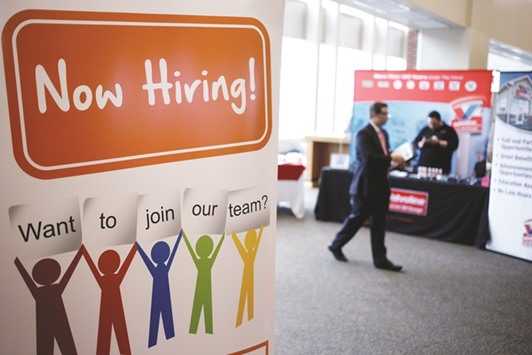The number of Americans filing for unemployment benefits unexpectedly held steady near a 43-year low last week, pointing to further momentum in the labour market after job growth surged in June.
Another report yesterday showed producer prices recorded their biggest gain in a year in June on rising costs for energy products and services.
The signs of sustained strength in the economy, together with a US stock market rally, could allow the Federal Reserve to raise interest rates later this year.
“The days of falling prices are pretty much over and the labour market is strengthening, which raises the question: Is anyone at the Fed paying attention?” said Joel Naroff, chief economist at Naroff Economic Advisors in Holland, Pennsylvania.
“Fed members, who fear anything that is not normal and hide from it, may want to peak out from under their rocks.”
Initial claims for state unemployment benefits were unchanged at a seasonally adjusted 254,000 for the week ended July 9, the Labour Department said.
Claims are near the 43-year low of 248,000 touched in mid-April.
Economists had forecast first-time applications for jobless benefits rising to 265,000 in the latest week.
Claims have now been below 300,000, a threshold associated with a healthy labour market, for 71 straight weeks, the longest stretch since 1973.
The four-week moving average of claims, considered a better measure of labour market trends as it irons out week-to-week volatility, fell 5,750 to 259,000 last week.
The labour market is on a strong footing, with nonfarm payrolls having increased by a robust 287,000 jobs in June, which should underpin economic growth for the rest of the year.
Data later this month is expected to show a rebound in economic activity in the second quarter after growth slowed to a 1.1% annualised rate at the start of the year.
The Fed kept rates unchanged at its policy meeting in June, citing persistently low inflation and worries about the labour market after job growth weakened sharply in May.
Policymakers were also cautious ahead of Britain’s June 23 referendum on whether to remain in the European Union.
While uncertainty over the so-called Brexit lingers, economists expect it to have limited impact on the US economy.
The recent rally on Wall Street has signalled that investors feel the same way.
“The economy is strong enough for the Fed to raise rates in September and we wouldn’t be surprised if they signal September is possible when they meet next in two weeks,” said Chris Rupkey, chief economist at MUFG Union Bank in New York.
The US central bank holds its next policy meeting on July 26-27.
US stocks were trading higher yesterday, extending their record-setting rally for a fourth day, even as the Bank of England surprised investors by leaving interest rates unchanged.
Prices for US government debt fell, while the dollar was little changed against a basket of currencies.
In a second report, the Labor Department said its producer price index for final demand rose 0.5% last month, the largest gain since May 2015, after advancing 0.4% in May.
In the 12 months through June, the PPI increased 0.3%, rising for the first time since December 2014, after slipping 0.1% in May. Overall inflation remains below the Fed’s 2% target.
Producer inflation is being boosted by the fading drag from a strong dollar and lower oil prices.
The dollar’s rally appears to be over after vaulting 20% between June 2014 and December 2015.
It has slipped on a trade-weighted basis this year while oil prices have rebounded from multi-year lows.
The core PPI, which excludes food, energy and trade services, rose 0.3% in June after slipping 0.1% in May.
It was up 0.9% in the 12 months through June.
The core PPI increased 0.8% in May.
“Stronger wage growth and stabilisations in energy prices and the US dollar should eventually lead to an acceleration in inflation,” said Gus Faucher, deputy chief economist at PNC Financial Services in Pittsburg.

A sign is displayed at a career fair at Papa John’s Cardinal Stadium in Louisville, Kentucky. Initial claims for state unemployment benefits were unchanged at a seasonally adjusted 254,000 for the week ended July 9, the Labour Department said yesterday.


